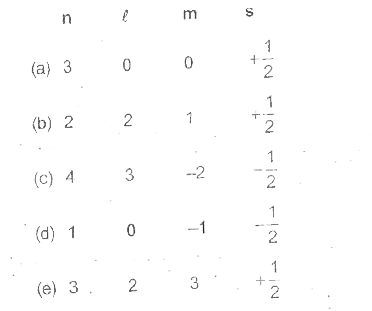select the inmpossible set of quantum numbers
nlms(a)40−1+12
nlms(b)33+2−12
nlms(c)310−12
nlms(d)21−1+12
The correct Answer is:a,b
To determine the impossible set of quantum numbers, we need to understand the rules governing quantum numbers. Quantum numbers describe the properties of atomic orbitals and the electrons in those orbitals. The four quantum numbers are:
1. Principal quantum number (n): This can take positive integer values (n = 1, 2, 3, ...).
2. Azimuthal quantum number (l): This can take integer values from 0 to (n-1).
3. Magnetic quantum number (ml): This can take integer values from -l to +l, including zero.
4. Spin quantum number (ms): This can take values of +1/2 or -1/2.
Now, let’s analyze a hypothetical set of quantum numbers to find an impossible set.
1. Identify a Set of Quantum Numbers: Let’s consider the set (n = 2, l = 2, ml = 1, ms = +1/2).
2. Check the Principal Quantum Number (n):
- n = 2 is valid since n must be a positive integer.
3. Check the Azimuthal Quantum Number (l):
- l must be in the range of 0 to (n-1). For n = 2, l can be 0 or 1.
- Here, l = 2 is invalid because it exceeds n-1 (which is 1).
4. Check the Magnetic Quantum Number (ml):
- ml can take values from -l to +l. Since l = 2 is invalid, we do not need to check ml further.
5. Check the Spin Quantum Number (ms):
- ms = +1/2 is valid as it can be either +1/2 or -1/2.
6. Conclusion: Since l = 2 is not a valid value for n = 2, the set (n = 2, l = 2, ml = 1, ms = +1/2) is impossible.
Final Answer:
The impossible set of quantum numbers is (n = 2, l = 2, ml = 1, ms = +1/2).
---
2. Azimuthal quantum number (l): This can take integer values from 0 to (n-1).
3. Magnetic quantum number (ml): This can take integer values from -l to +l, including zero.
4. Spin quantum number (ms): This can take values of +1/2 or -1/2.
- n = 2 is valid since n must be a positive integer.
- l must be in the range of 0 to (n-1). For n = 2, l can be 0 or 1.
- Here, l = 2 is invalid because it exceeds n-1 (which is 1).
- ml can take values from -l to +l. Since l = 2 is invalid, we do not need to check ml further.
- ms = +1/2 is valid as it can be either +1/2 or -1/2.
The impossible set of quantum numbers is (n = 2, l = 2, ml = 1, ms = +1/2).
Topper's Solved these Questions
- QUANTUM NUMBERS AND GENERAL CHEMISTRYBook:GRB PUBLICATIONChapter:QUANTUM NUMBERS AND GENERAL CHEMISTRYExercise:comprehension type
Explore 5 Videos
- QUANTUM NUMBERS AND GENERAL CHEMISTRYBook:GRB PUBLICATIONChapter:QUANTUM NUMBERS AND GENERAL CHEMISTRYExercise:comprehension type2
Explore 1 Video
- QUANTUM NUMBERS AND GENERAL CHEMISTRYBook:GRB PUBLICATIONChapter:QUANTUM NUMBERS AND GENERAL CHEMISTRYExercise:reasoning type
Explore 6 Videos
- PRACTICAL ORGANIC CHEMISTRYBook:GRB PUBLICATIONChapter:PRACTICAL ORGANIC CHEMISTRYExercise:Exercise 4 (Matrix match type )
Explore 1 Video
- REDOX REACTIONSBook:GRB PUBLICATIONChapter:REDOX REACTIONSExercise:All Questions
Explore 332 Videos
Similar Questions
Knowledge Check
Select the correct set (s) of quantum numbers
An=3,l=0,ml=−1Bn=3,l=3,ml=−2Cn=3,l=2,ml=−2Dn=3,l=1,ml=0which of the following is an impossible set of quantum number ?
An=3,l=2,m=0,s=+12Bn=3,l=2,m=−2,s=+12Cn=3,l=2,m=−3,s=+12Dn=3,l=2,m=−1,s=−12Which of the following is impossible set of quantum numbers.
An−3,l=2,m=1,s=+12Bn=4,l=2,m=12,s=+12Cn=3,l=1,m=0,=12Dn=5,l=1,m=−1,s=−12
Amongst the following set of quantum numbers, the impossible set is
View SolutionConsider the following sets of quantum numbers

which of the following sets of quantum number is not possible ?
View SolutionElectrons will first enterinto the orbital with the set of quantum numbers
View SolutionWhich of the following set of quantum numbers is not consistent with the theory ?
View SolutionConsider the following sets of quantum number

Which of the following sets of quantum number is not possible?
View Solution

